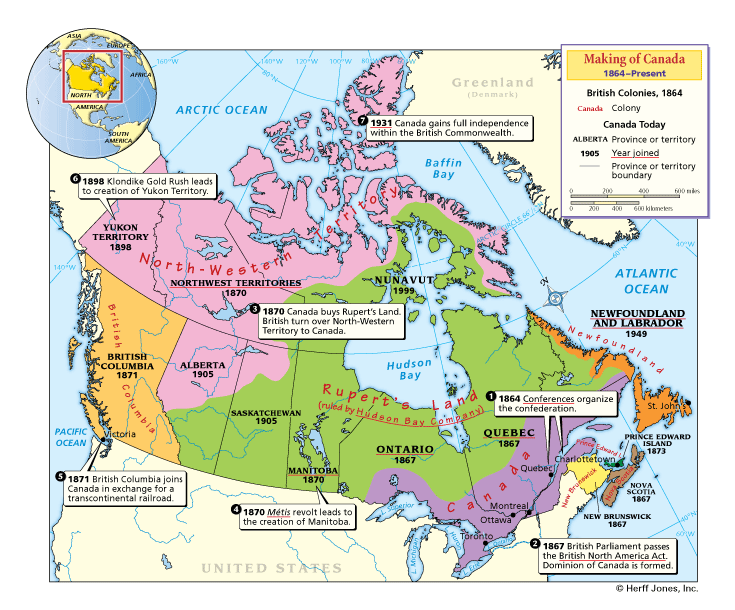
Most of Canada's provinces and territories have changed their boundaries since first joining Canada. This year date refers to the first time the province or territory was organized either because it joined Canada (such as British Columbia or Newfoundland) or because it was created out of existing Canadian territory (such as Alberta or Nunavut).
The Hudson Bay Company was created in 1670 when it was granted a monopoly on England's northern fur trade. This monopoly took full control over Rupert's Land. The company also established farming colonies for whites and Métis in the Red River Valley near modern Winnipeg. After selling Rupert's Land to Canada, the Hudson Bay Company became a chain of retail stores. It continues today and is the oldest continuously operating company in the world.
Newfoundland participated in the 1864 Charlottetown Conference to unify the British Atlantic colonies. However, Newfoundland chose to remain a separate, self-governing colony rather than join the confederation. Newfoundland joined Canada after World War II.
Quebec was originally a French colony. In 1840 Quebec, then called Lower Canada, joined Upper Canada (Ontario). Quebec remains the only French-majority province
Upper Canada was settled by British immigrants and Loyalists who escaped the American Revolution. When the confederation was created, Quebec and Ontario were split again. Ontario is the largest province today.
As Canada negotiated with the Hudson Bay Company for Rupert's Land, the Métis in the Red River Valley feared that Canadian settlers would take away their land and rebelled. To prevent future uprisings, the Canadian government created a new province named Manitoba and guaranteed the land rights of the Métis.
Originally the Northwest Territories included all Canadian land that did not belong to a province. Since 1870, two provinces and two territories have been created out of it. Additional land has been given to Manitoba, Ontario, Quebec, and Newfoundland and Labrador.
In the 1860s the British and Canadians feared the growing armies of the American Civil War. A free, united Canada was seen as a less tempting target than British colonies. Newfoundland, Prince Edward Island, Nova Scotia, and New Brunswick held a conference in Charlottetown for united self-government. When Canada asked to join, a new conference was held in Quebec. The Quebec Conference laid the groundwork for the 1867 British North America Act (Constitution Act).
The British North America Act, also called the 1867 Constitution Act, established the powers of the federal parliament, the provinces, the British parliament, and the monarch. Foreign affairs and some domestic powers remained under British control.
Métis are people with mixed European and Indigenous ancestry. Today the Métis are recognized as an indigenous community with treaty rights protecting their community's sovereignty.
After the First World War, Canada increasingly insisted on control over its foreign and domestic affairs. The 1931 Statue of Westminster ended British control over Canada. Today the British government has no authority over Canada although the Queen still reigns as a constitutional monarch through her governor-general.